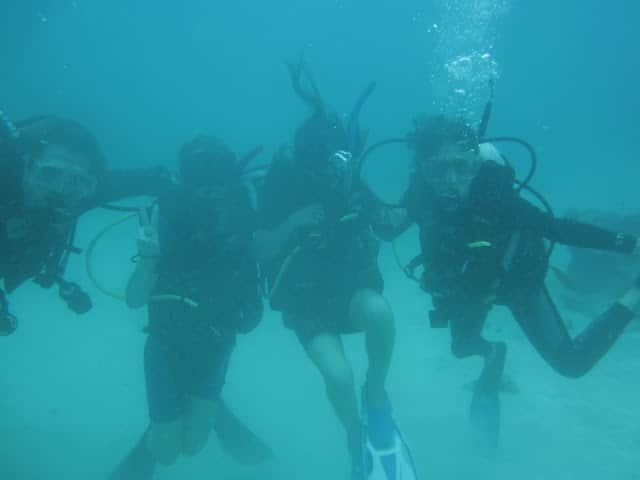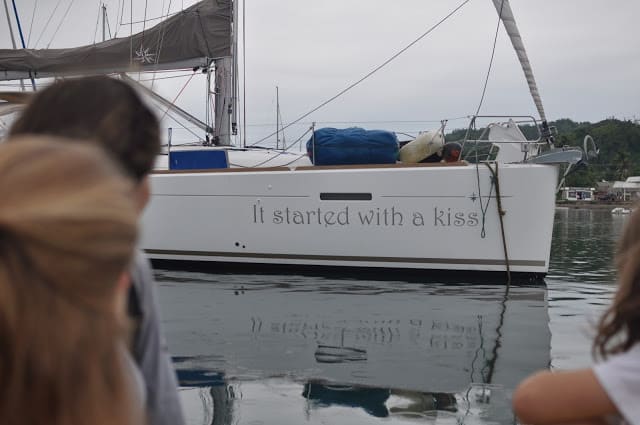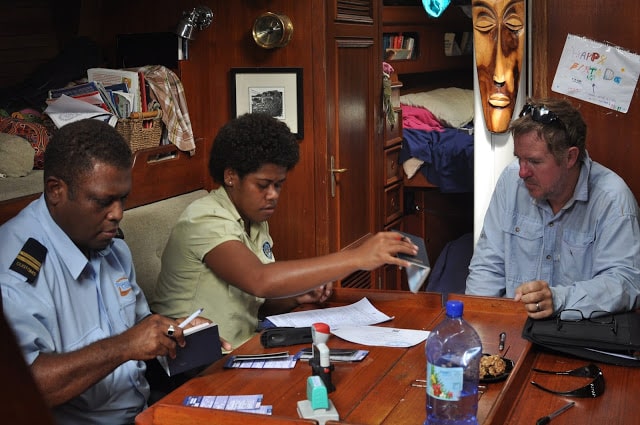
So Fijian society is much like Samoan society, in that outside the cities, communities are structured around autonomous villages on communal land. Even today, the villagers’ relationship to the land is best expressed in this paragraph I pulled from Wikipedia:
“The living soul or human manifestation of the physical environment which the members have since claimed to belong to them and to which they also belong. The land is the physical or geographical entity of the people, upon which their survival…as a group depends. Land is thus an extension of the self. Likewise the people are an extension of the land. Land becomes lifeless and useless without the people, and likewise the people are helpless and insecure without land to thrive upon.”
There is a chief of every village. This elder man has considerable power and influence. He is judge and jury in criminal matters, deciding who gets punished and how. He controls distribution of land assets and the manner in which people work and live among those assets.
Because there is no public space as we know it, entering a Fijian village (and this includes anchoring in the waters off a village) as an outsider—whether Fijian or not—demands adherence to protocols that have been a part of this culture for millennia. The first thing a visitor must do is to seek out the chief to present a sevusevu. This is a Fijian term for token of respect. As far as I know, the only acceptable token is kava, in its un-ground form. From what I’ve heard, it’s never difficult to find the chief to present sevusevu, anyone who sees you will recognize you as a stranger and take you to the chief. When you meet the chief, you don’t shake his hand or touch him, you sit before him and place your sevusevu in front of him. You politely state your business in the village and wait. When he picks up your sevusevu, you are golden. You may be asked to join the chief and others in drinking kava and it’s incumbent on you to accept that invitation.
“Over there, in the market, you can buy kava for your sevusevu before we leave.” Windy heeded our cab driver’s advice and walked across the busy bus terminal to buy a handful of dried sticks wrapped in newspaper like a bouquet.
Seriously? We just want to go to the waterfall to relax and cool off.
Arriving in the larger city of Savusavu, the village culture didn’t apply. This would be our first time venturing outside of Fijian city life. This would apparently be our first opportunity to present sevusevu. I wasn’t eager for this; I sensed touristy artifice.

Twenty minutes later, we left the main road and bounced along a pocked dirt road in a lush, steep-walled valley.
“We’re almost to the Vuadomo village. The waterfall is back that way,” our driver said pointing over his shoulder. “Once you present your sevusevu, I’ll bring you to the trailhead.”
“Everyone take off your hat and sunglasses,” Windy announced from the back seat. I looked over at our Indian driver, my eyebrows raised in a question. He nodded at me.
“Are we going to sit in a kava circle?” I asked him.
“No, you’ll just present your sevusevu and ask permission to visit the falls.”
“Might he say no?” I asked.
“No. And when you’re done, you’ll need to pay a fee to use the fall; it’s eight dollars per person.”
Hmmm.
The fall guy. The old Toyota sedan stopped and I squinted into the sunlight. Several women sat in the shade, each before a pile of touristy trinkets, ashtrays and shot glasses with “Bula!” printed in bold letters, for sale among shell necklaces and other things I was pretty sure nobody in this village produced.
“Bula!” we called out warmly. They motioned us over to survey their wares. We all decided on the most practical thing we could buy: an 8-ounce plastic bottle of coconut oil that was pressed locally. Then Eleanor bought a pair of earrings. Then someone said the chief was coming and told us to sit on a nearby bench. A woman took our kava bouquet from Windy.
The chief was small, old, dark-skinned, and wrinkled. He sat quietly on a mat about 10 feet from us and nobody made a peep. The woman who’d taken our kava placed it gently before him and backed away. He didn’t pick up our sevusevu. He didn’t look at us. He sat quietly for a minute. Then he started talking in Fijian, eyes closed. The seated women nodded. At some point he picked up our sevusevu and regarded it carefully, like it was something he’d not seen before, all the while talking to himself in Fijian. During this, the half-dozen women periodically clapped in unison, obviously in response to the chief. Then, he set the kava back down, stood, and walked, stooping heavily, back to the village house he’d come from. One of the women picked up the kava and followed him.
“Are we good?”
“All good.” One of the women said.
Then we paid the fee, got back into the cab, and drove to the trailhead.
“I’ll be back to pick you up at 3:00 p.m.” Our cab driver said.
Our first sevusevu presentation was probably different from what Captain Cook likely experienced. Seeing as how hundreds and hundreds of tourists visit this particular waterfall every year, it was probably nothing like what we would have experienced in communities a bit farther off the beaten path. But neither did I get the impression these folks were doing a song and dance for the tourists before retreating to their homes, pulling the iPhone 6 out of a hidden pocket, and resuming a Facebook dialog. Fiji is among the most affluent and developed of the Pacific Island nations—in comparison, way beyond Tonga by these measures—but the traditional culture is by no means completely diffused.
We’ve not yet experienced the outer island culture, but where we’ve been, it feels like we’re in a country with a healthy social dynamic. The vibe here is good. People seem content. I’m sure it’s not nirvana, and we’ve been here only just over a month, but there’s a warmth and genuineness and kindness that we get from nearly every interaction with a Fijian (and this from an eternal skeptic). It’s an easygoing politeness that strikes us.

Bulla
Damn, I thought to myself when we first arrived in Fiji, how do all these people get stuck wearing the wrong size flip-flops? Men, women, and children alike all wear flip-flops, always the cheapest thinnest-soled kind—the ones they sell in the drug store for $1.99. But on Fijian feet—and I remember seeing the same thing in the Samoas—every pair is just way too small. The tips of toes hang over the flip-flop fronts and soles disappear under bare heels. A size 7 shoe is the same price as a size 9, so it can’t be a money thing.
The other day, walking down Savusavu’s waterfront street in the rain, wearing my generous-sized Tahitian flip-flops, I felt the little water droplets filled with street grime flicking up onto the backs of my calves with every step. My questions disappeared. All the calves of the Fijians around me were clean. Damn, I gotta trim my flip flops.
Fiji is turning out to be an interesting place (for more reasons than the flip-flop conundrum). We’re rather enjoying it. The population seems to be an equal mix of afro-haired Melanesians and Indians. But they’re all Fijian. The Indians arrived generations ago and one man I spoke with said he is no more familiar with India then I am with Ireland/Sweden. But the difference between the Fijian Indians and melting-pot Americans like me, is that the Indian culture is preserved here among Fijian Indians who have never been to India and have no plans to go. Religion, language, and dress are all unmistakably Indian. I can choose from several brands and sizes of ghee in every store and turmeric and masala is sold by the kilo. We ride on buses owned by a company called Vishnu and the pirated-DVD stores are filled with Bollywood titles.
I asked the same Indian gentleman about relations between the Indians and native Fijians. Contrary to my limited understanding of politics here, he said there are no problems. He said that inter-racial relationships are not unheard of, but that they aren’t common. I asked if either group is relegated to a lower class. He said no. Then he said that native Fijians don’t keep their houses clean like the Indians keep their houses.
Fiji is inexpensive for cruising sailors, and not just compared to the rest of the South Pacific. We’re currently sitting on a mooring in front of a plush resort. The mooring is free and we have full access to all of the resort amenities. We got our 10-gallon propane tank filled in Savusavu for US$6.50. There were a dozen Indian food restaurants around Savusavu and the plates are a great value. The four of us enjoyed one excellent sit-down Indian dinner with rice, curries, roti, and drinks for US$15–total. At the awesome Waitui Marina in Savusavu, we twice stuffed ourselves on the all-you-can-eat Indian buffet for US$7.50 per person (cheaper for the girls). The pumpkin curry and dahl and roti were out of this world.
Remarkably, I can say that every person we’ve met in three weeks in Fiji has been genuinely friendly and welcoming and accommodating. Parts of this country were devastated by Cyclone Winston this past season, and the effects are still evident, all around. Rebuilding is in full swing and from an arriving visitor’s perspective, among a people of an economy that depends on tourism, I have the sense everyone is sincerely pleased that we are here, that they recognize the import of ensuring the few visitors who are here, return home with positive reports from Fiji.
So what’s bad about this place? Well, it’s the dead of winter and we’ve had very few clear, sunny days since we arrived. (I feel badly for the few fly-in tourists we’ve seen who’ve spent their 10-day resort vacations in the rain and drizzle.) But apparently, this spat of inclement weather is unusual. I can report that the check-in fees are steep (just under US$200) and the process was more demanding than most countries we’ve visited. In fact, a week before we arrived, we were required to fill out a dozen-page form and send a copy of it—along with a photo of Del Viento and a photocopy of my passport—to Fijian Customs. Then, upon arriving, we had Customs, Immigration, Health, and Bio-Security officials aboard before we could go ashore. Then we had to later rendezvous in town at the offices of all but immigration to pay. Additionally, we are technically required to report our whereabouts weekly. But we’re used to the paper chase and we take it in stride.
We’ll be here for a spell, so stay tuned for reports and photos from Fiji. It’s a good place to be.








